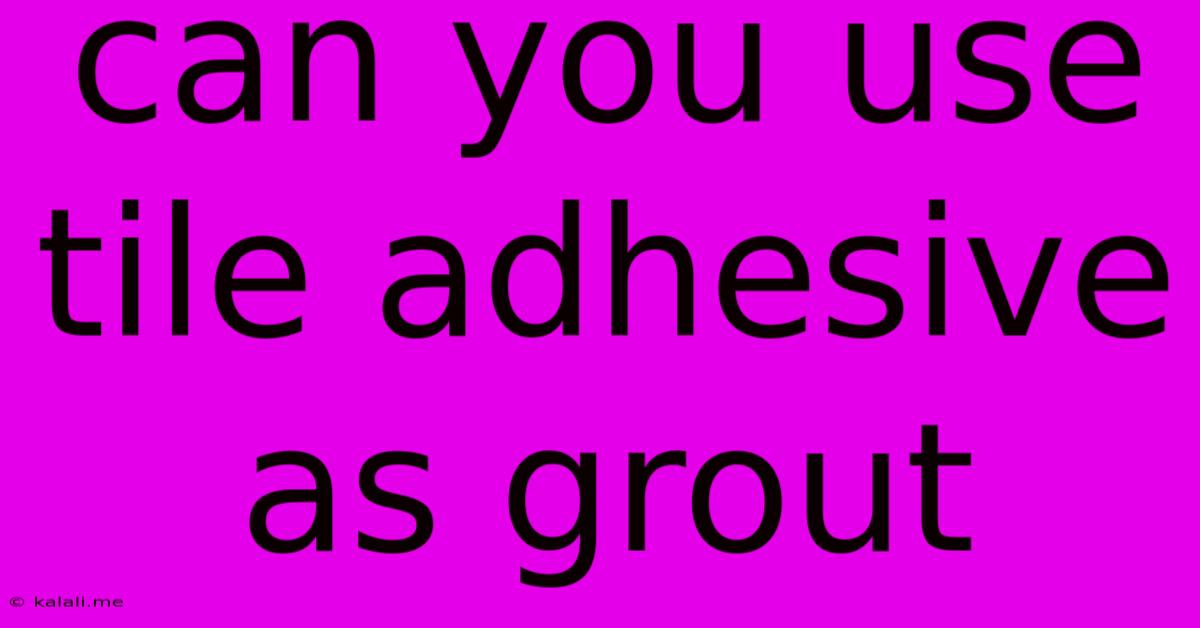Can You Use Tile Adhesive As Grout
Kalali
May 19, 2025 · 3 min read

Table of Contents
Can You Use Tile Adhesive as Grout? A Comprehensive Guide
So, you're tiling a project, and you're faced with a dilemma: you've run out of grout, and you're wondering if you can use tile adhesive as a substitute. The short answer is no, you shouldn't use tile adhesive as grout. While they share some similarities, they have distinct properties and purposes, and using one in place of the other can lead to serious problems. This article will delve into the reasons why, explaining the differences between tile adhesive and grout, and outlining the potential consequences of using adhesive as grout.
Tile adhesive and grout are both used in tile installations, but they serve very different functions and have vastly different properties. Tile adhesive is designed to bond tiles securely to the substrate (e.g., wall, floor), providing strong adhesion and structural support. Grout, on the other hand, fills the spaces between tiles (the joints), preventing water penetration, protecting the tiles from cracking, and providing a finished aesthetic.
Key Differences Between Tile Adhesive and Grout
Here's a breakdown of the critical differences:
-
Consistency: Tile adhesive is typically thicker and more viscous than grout. This viscosity is crucial for its bonding capabilities. Grout, conversely, is designed to be pourable and easily spreadable to fill narrow gaps.
-
Flexibility: Tile adhesive is generally less flexible than grout. This inflexibility can be problematic in areas prone to expansion and contraction, such as exterior walls or floors subjected to temperature fluctuations. Grout's flexibility helps it withstand these movements without cracking or separating.
-
Water Resistance: While both products have some degree of water resistance, grout is specifically formulated to be highly water-resistant, crucial for preventing water damage and mold growth, particularly in wet areas like bathrooms and kitchens. Tile adhesive is primarily designed for adhesion, not waterproofing.
-
Appearance: Grout comes in a wide array of colors and finishes, contributing significantly to the overall aesthetic appeal of a tiled surface. Tile adhesive is typically a single, muted color and doesn't offer the same range of design options.
-
Durability and Longevity: Grout is designed to withstand the wear and tear of daily use, maintaining its structural integrity and appearance over time. Improperly applied tile adhesive in the grout lines will likely crack, crumble, and discolor prematurely, compromising the overall look and longevity of your tile work.
Consequences of Using Tile Adhesive as Grout
Using tile adhesive as grout can lead to several negative outcomes:
-
Cracking and crumbling: The lack of flexibility in tile adhesive makes it prone to cracking and crumbling, particularly in areas that experience movement or expansion and contraction. This will quickly ruin the aesthetic appeal of your tiling project.
-
Water damage: The inferior water resistance of tile adhesive compared to grout increases the risk of water penetration, leading to potential mold growth, structural damage, and costly repairs.
-
Difficult Cleaning: The thick consistency of tile adhesive makes it challenging to clean and maintain, unlike the smoother surface provided by proper grout.
-
Poor Aesthetics: The limited color options and rough texture of tile adhesive will leave your tiled surface looking unprofessional and unfinished.
Conclusion
In short, don't substitute tile adhesive for grout. While the temptation to use what's on hand might be strong, the potential for damage and the cost of remediation far outweigh any perceived savings. Investing in the proper grout will ensure a beautiful, long-lasting, and structurally sound tiled surface. Choosing the right grout for your project—considering factors like the location, tile type, and desired aesthetic—is crucial for achieving a successful outcome. Remember to always follow the manufacturer’s instructions for both your tile adhesive and grout for optimal results.
Latest Posts
Latest Posts
-
Can You Make Cheese Sauce With Self Raising Flour
May 19, 2025
-
Can You Take Contact Lenses In Hand Luggage
May 19, 2025
-
Run Bash Script From Bash Script
May 19, 2025
-
How Long Will Motor Oil Last
May 19, 2025
-
All Is Fair In Love And War Origin
May 19, 2025
Related Post
Thank you for visiting our website which covers about Can You Use Tile Adhesive As Grout . We hope the information provided has been useful to you. Feel free to contact us if you have any questions or need further assistance. See you next time and don't miss to bookmark.